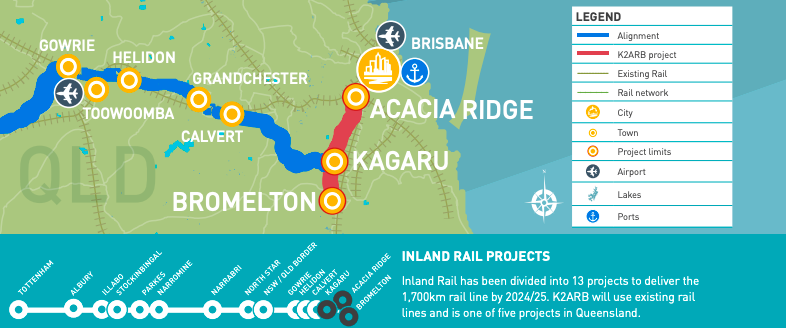A regional Queensland council says it’s being brick-walled from decision making around the planned Inland Rail despite the project having potentially dire consequences for residents.

The Inland Rail, the biggest freight rail infrastructure project in the country, is a 1700km network that will connect Melbourne and Brisbane via regional Victoria, NSW and Queensland.
It’s being delivered by the government owned statutory corporation the Australian Rail Track Corporation (ARTC), which says the project will bring huge benefits by linking farmers and producers to national and global markets and reducing the burden on roads.
The bone of contention for Logan City Council is the proposed 49km Kagaru to Acaia Ridge and Bromelton corridor running through the western side of the City of Logan local government area on the existing interstate rail line.
It’s currently in the feasibility stage with construction scheduled to begin in 2022.

Logan City Council Mayor Darren Power told a Senate inquiry on Wednesday the corridor will cut through densely populated suburbs, with some 38,000 residents living within 1km of the proposed line.
He says landowners face a substantial increase in the size and frequency of trains that will disrupt their everyday lives.
No silver bullet for Logan: Mayor
Cr Power said up to eight trains currently use the existing line. When the project is finished in 2040, that will increase to 45 trains a day, up to 3.6km long and potentially double stacked, 24 hours a day.
He said the increased noise would become “unbearable” for some residents and homes would be “devalued overnight”.
He told the committee that LCC has constantly raised concerns with the ARTC but question have gone unanswered or been met with unsatisfactory responses.
He also complained about lack of meaningful community consultation and a two-year “drawn out anxiety-inducing process with no clear end in sight”.
Cr Power said the Inland Rail has been touted as a silver bullet for a post-covid economy, but Logan will reap scant economic benefits while bearing all the negative impacts.
“My fellow councillors and I demand accountability from the ARTC and the state and federal government in managing the environmental impacts that have the potential to degrade people’s quality of life along the corridor,” he said.
The case for Gladstone
Also on Wednesday, John Abbott, project manager for the Central Queensland Region Organisation of Councils (CQRQ), argued the case to extend the Inland Rail from Toowoomba to Gladstone.
“Our submission to this committee is that the design of the Inland Rail needs to be reconfigured and it should include a link to the Port of Gladstone,” he said.
He said this would facilitate decentralisation and regional growth and could see Gladstone Port become the fourth major container port on the East Coast.
It would also deliver the objectives of the Inland Rail with a reduction in capital expenditure of up to $4 billion and a shorter timeline, Mr Abbot said.
The proposal is supported by Banana Regional Council and Gladstone Regional Council.
The Senate committee is due to report on February 11.





There were a number of key points repeated by the speakers that came out of the presentations provided being:
1) Acacia Ridge has never been studied by ARTC to determine if logistically it can cater for the number of trains and containers and truck traffic distribution of containers to prove this terminal is fit for Inland Rail purpose.
It was clear from a number of speakers that ARTC have blindly followed State and Federal directives to terminate at Acacia Ridge without carrying out the basic studies
five years ago prior to commencing their management of construction.
2) The Port of Brisbane does not have the capacity nor the road and rail links to cater for the proposed increase in freight and an alternate port should be considered.
The Port of Brisbane also lacks the draft depth required for the new larger container ships and this is a problem the port will struggle to overcome with a single channel access.
3) Although a number of alternate multimodal terminal locations were discussed the overall location with the most advantages was clearly Toowoomba to unload the 70% SE Qld freight containers with easy main road and existing rail access to Brisbane, Gold Coast, Sunshine coast and cities west of Toowoomba
4) The gains to Inland Queensland with the provision of a rail link access to a prime seaport at Gladstone with adequate draft depth for the largest ships and with minerals and container would be huge for regional Qld.
Mr Corbett is spot on with his comments. Have been following this “project” for nigh on 4 years and there are a lot of unanswered questions from government and ARTC. The current route does not make sense. Mr Corbett has summarised beautifully how it should be managed.
1864 Queensland adopted Narrow gauge rail as its network model.
[It now has the 2nd largest Narrow gauge railway in the world. ]
ARTC being a Federal Government organisation. Standard gauge operation is its network model.
Effectively ARTC is stuck with the Acacia ridge site, that’s where Standard gauge track goes, unless the state of Queensland agrees otherwise Any of the findings from studies that have been done on Acacia Ridge are irrelevant.
The rivalry of States and Federal governments continues to allow break in gauge to hamstrung every one of the benefits of one consistent Rail gauge as a efficient and environmentally better transportation mode.
So, Rail within and into Queensland is that states decision.
Would Gladstone be better As a port I expect Yes.
But the task is to get freight to Brisbane as time efficiently as possible by Rail!
The big issue is that Queensland doesn’t want Standard gauge network. Even if they would benefit from the increased connect and I guess no one can make them, unless you voter in that state!
While we have states that don’t work together and make Australia work better for everyone, then the mess of inland rail to Acacia ridge is a picture of the consequence of a Federation continues to show that doesn’t work well!
To have Coal Trains and freight trains 24 hours a day running through the suburbs is crazy. Shopping Centers, Schools and Kindergardens are already located alongside and will become covered with coal dust and diesel fumes. Just like the NBN which had fibre to the node and bottle necked with copper to the house waisting billions of dollars now spendings billions on rail for it to stop at Acacia Ridge to then go by road on already congested Gateway Motorway. Another pink elephant.
This needs to be sorted out urgently
Please, let common sense prevail.
Federal Govt needs to look into this before it is too late.